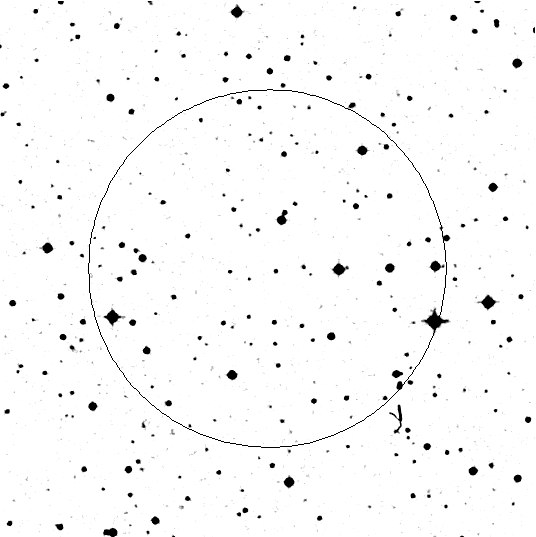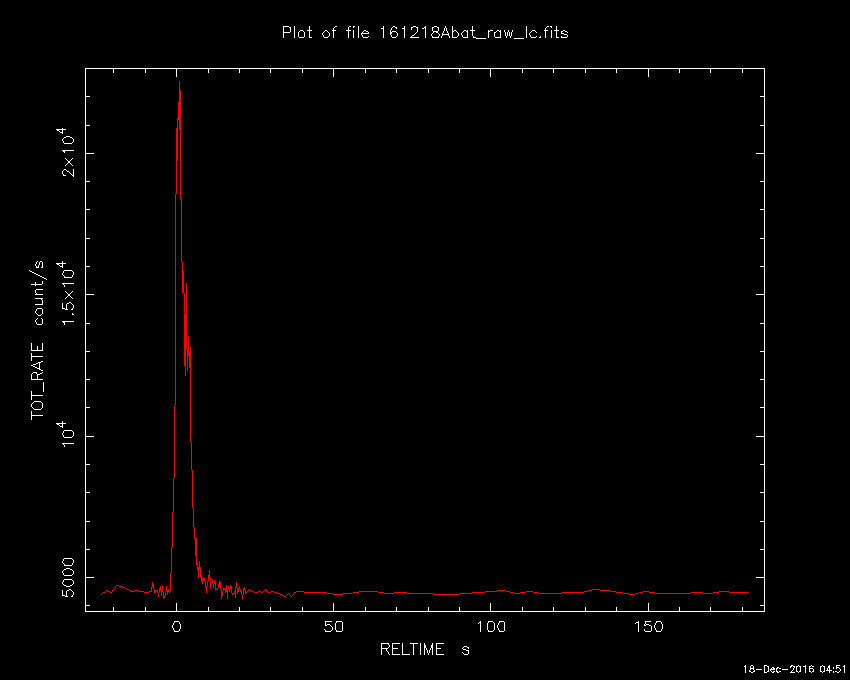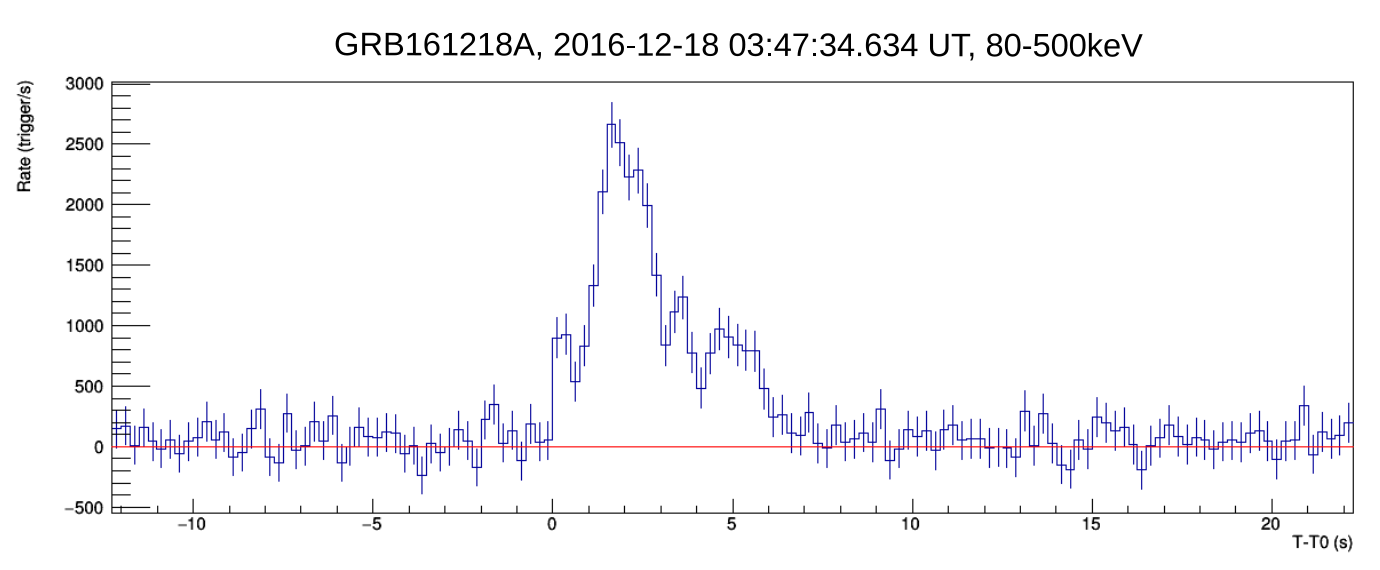- GCN/BACODINE POSITION NOTICE
TITLE: GCN/SWIFT NOTICE
NOTICE_DATE: Sun 18 Dec 16 03:47:57 UT
NOTICE_TYPE: Swift-BAT GRB Position
TRIGGER_NUM: 727288, Seg_Num: 0
GRB_RA: 245.257d {+16h 21m 02s} (J2000),
245.481d {+16h 21m 55s} (current),
244.599d {+16h 18m 24s} (1950)
GRB_DEC: -4.114d {-04d 06' 48"} (J2000),
-4.153d {-04d 09' 09"} (current),
-3.996d {-03d 59' 43"} (1950)
GRB_ERROR: 3.00 [arcmin radius, statistical only]
GRB_INTEN: 14772 [cnts] Image_Peak=2729 [image_cnts]
TRIGGER_DUR: 1.024 [sec]
TRIGGER_INDEX: 146 E_range: 25-100 keV
BKG_INTEN: 18690 [cnts]
BKG_TIME: 13638.67 SOD {03:47:18.67} UT
BKG_DUR: 8 [sec]
GRB_DATE: 17740 TJD; 353 DOY; 16/12/18
GRB_TIME: 13656.14 SOD {03:47:36.14} UT
GRB_PHI: -68.20 [deg]
GRB_THETA: 24.71 [deg]
SOLN_STATUS: 0x3
RATE_SIGNIF: 238.07 [sigma]
IMAGE_SIGNIF: 25.38 [sigma]
MERIT_PARAMS: +1 +0 +0 +0 +2 +9 -100 +0 -88 +0
SUN_POSTN: 266.36d {+17h 45m 25s} -23.39d {-23d 23' 38"}
SUN_DIST: 27.87 [deg] Sun_angle= 1.4 [hr] (West of Sun)
MOON_POSTN: 144.08d {+09h 36m 20s} +12.93d {+12d 55' 35"}
MOON_DIST: 102.02 [deg]
MOON_ILLUM: 78 [%]
GAL_COORDS: 9.57, 30.59 [deg] galactic lon,lat of the burst (or transient)
ECL_COORDS: 244.10, 17.13 [deg] ecliptic lon,lat of the burst (or transient)
COMMENTS: SWIFT-BAT GRB Coordinates.
COMMENTS: This is a rate trigger.
COMMENTS: A point_source was found.
COMMENTS: This does not match any source in the on-board catalog.
COMMENTS: This does not match any source in the ground catalog.
COMMENTS: This is a GRB.
COMMENTS: This trigger occurred at longitude,latitude = 142.43,-11.66 [deg].
- red DSS finding chart
ps-file

- GCN NOTICE
TITLE: GCN/SWIFT NOTICE
NOTICE_DATE: Sun 18 Dec 16 03:51:09 UT
NOTICE_TYPE: Swift-BAT GRB Lightcurve
TRIGGER_NUM: 727288, Seg_Num: 0
GRB_RA: 245.257d {+16h 21m 02s} (J2000),
245.481d {+16h 21m 55s} (current),
244.599d {+16h 18m 24s} (1950)
GRB_DEC: -4.114d {-04d 06' 48"} (J2000),
-4.153d {-04d 09' 09"} (current),
-3.996d {-03d 59' 43"} (1950)
GRB_DATE: 17740 TJD; 353 DOY; 16/12/18
GRB_TIME: 13656.14 SOD {03:47:36.14} UT
TRIGGER_INDEX: 146
GRB_PHI: -68.20 [deg]
GRB_THETA: 24.71 [deg]
DELTA_TIME: 12.00 [sec]
TRIGGER_DUR: 1.024 [sec]
SOLN_STATUS: 0x3
RATE_SIGNIF: 238.07 [sigma]
IMAGE_SIGNIF: 25.38 [sigma]
LC_URL: sw00727288000msb.lc
SUN_POSTN: 266.36d {+17h 45m 26s} -23.39d {-23d 23' 38"}
SUN_DIST: 27.87 [deg] Sun_angle= 1.4 [hr] (West of Sun)
MOON_POSTN: 144.11d {+09h 36m 27s} +12.92d {+12d 55' 09"}
MOON_DIST: 101.99 [deg]
MOON_ILLUM: 78 [%]
GAL_COORDS: 9.57, 30.59 [deg] galactic lon,lat of the burst (or transient)
ECL_COORDS: 244.10, 17.13 [deg] ecliptic lon,lat of the burst (or transient)
COMMENTS: SWIFT-BAT GRB Lightcurve.
COMMENTS:
COMMENTS: The next comments were copied from the BAT_POS Notice:
COMMENTS: This is a rate trigger.
COMMENTS: A point_source was found.
COMMENTS: This does not match any source in the on-board catalog.
COMMENTS: This does not match any source in the ground catalog.
COMMENTS: This is a GRB.
COMMENTS: This trigger occurred at longitude,latitude = 142.43,-11.66 [deg].

- GCN Circular #20283
A. D'Ai (INAF-IASFPA), V. D'Elia (ASDC),
H. A. Krimm (CRESST/NSF/USRA), D. M. Palmer (LANL) and
M. H. Siegel (PSU) report on behalf of the Swift Team:
At 03:47:36 UT, the Swift Burst Alert Telescope (BAT) triggered and
located GRB 161218A (trigger=727288). Swift could not slew to the burst
do to an observing constraint. The BAT on-board calculated location is
RA, Dec 245.257, -4.114 which is
RA(J2000) = 16h 21m 02s
Dec(J2000) = -04d 06' 48"
with an uncertainty of 3 arcmin (radius, 90% containment, including
systematic uncertainty). The BAT light curve showed a single complex
structure with a duration of about 10 sec. The peak count rate
was ~20000 counts/sec (15-350 keV), at ~1 sec after the trigger.
Due to a Sun observing constraint, Swift cannot slew to the BAT
position until 15:54 UT on 2017 January 08. There will thus be no XRT
or UVOT data for this trigger before this time.
Burst Advocate for this burst is A. D'Ai (antonino.dai AT ifc.inaf.it).
Please contact the BA by email if you require additional information
regarding Swift followup of this burst. In extremely urgent cases, after
trying the Burst Advocate, you can contact the Swift PI by phone (see
Swift TOO web site for information: http://www.swift.psu.edu/too.html.)
- GCN Circular #20287
Z. H. Li (IHEP), Y. H. Wang (IHEP), S. L. Xiong (IHEP)=20
report for the POLAR collaboration:
At=A02016-12-18T03:47:34.634=A0UT=A0(T0),=A0during=A0a=A0routine=A0on-ground=A0
search=A0of=A0data,=A0POLAR=A0detected the GRB 161218A,=A0
which=A0was=A0also=A0detected=A0by=A0the=A0Swift/BAT (trigger #727288).
The=A0POLAR=A0light=A0curve=A0consists=A0of=A0a single=A0peak,
with=A0a=A0duration=A0(T90) of=A06.76=A0s=A0measured=A0from=A0T0+0.25=A0s .
The=A00.25s=A0peak=A0rate=A0measured=A0from=A0T0+1.25=A0s=A0is=A02660=A0cnts/s,
The=A0total=A0counts=A0is=A0about=A06644 cnts. The=A0above=A0measurements=A0are
in=A0the=A0energy=A0range=A0of=A0about=A080-500=A0keV.
The preliminary estimation of minimum detectable polarization (MDP)
is 32.5%[3-sigma, statistical only]. Follow-up observations are
strongly encouraged.
LC_URL:
http://polar.ihep.ac.cn/grb/2016/GRB161218A/lc/POLAR_lc_grb161218158.png
Using=A0the=A0best=A0location=A0from=A0the=A0Fermi/GBM,=A0which=A0is=A0(J2000):
RA:=A0=A0=A0 245.257=A0=A0 [deg]
Dec:=A0=A0 -4.114=A0=A0 [deg]
Err:=A0=A0=A0=A0=A03.00 [arcmin]
the=A0incident=A0angle=A0in=A0POLAR=A0coordinate=A0at=A0T0=A0is:
theta:=A0 24.327 =A0[deg]
phi: =A0=A0356.614=A0 [deg]
The=A0analysis=A0results=A0presented=A0above=A0are=A0preliminary.
POLAR is a dedicated Gamma-Ray Burst polarimeter (50-500 keV) on-board
the Chinese space laboratory Tiangong-2 launched on Sep 15, 2016. More
information about POLAR can be found at http://polar.ihep.ac.cn/en/ ,
http://isdc.unige.ch/polar/ and http://polar.psi.ch/html/ .

- GCN Circular #20290
Klotz A., Turpin D., Atteia J.L. (CNRS-OMP-IRAP),
Boer, M., Laugier, R. (CNRS-ARTEMIS),
Gendre B. (UVI - Etelman Obs.) report:
We imaged the field of GRB 161218A detected by SWIFT
(trigger 727288) with the TAROT robotic telescope (D=25cm)
located at the Calern observatory, France.
The observations started 49 min after the GRB trigger
at the end of the night. The elevation of the field
increased from 3 degrees above horizon and weather
conditions were good.
We co-added a series of exposures.
We do not detect any OT with a limiting magnitude of:
t0+49 min to t0+68 min : Rlim = 17.3
Magnitudes were estimated with the nearby USNO-B1 stars
and are not corrected for galactic dust extinction.
- GCN Circular #20292
D. Frederiks, S. Golenetskii, R.Aptekar, P. Oleynik, M. Ulanov,
D. Svinkin, A. Tsvetkova, A.Lysenko, A. Kozlova, and T. Cline,
on behalf of the Konus-Wind team, report:
The long GRB 161218A (Swift-BAT detection: D'Ai et al., GCN 20283;
POLAR observation: Li et al., GCN 20287)
triggered Konus-Wind at T0=3D13651.970 s UT (03:47:31.970).
The burst light curve shows a single pulse with a total duration
of ~7 s.
The emission is seen up to ~10 MeV.
As observed by Konus-Wind, the burst had a fluence of
(1.24 =B1 0.10)x10^-5 erg/cm2 and a 64-ms peak energy flux,
measured from T0+0.640, of (4.6 =B1 0.4)x10^-5 erg/cm2
(both in the 20 keV - 10 MeV energy range).
The time-integrated spectrum (measured from T0 to T0+10.496 s)
is best fit in the 20 keV - 15 MeV range
by the GRB (Band) function with the following model parameters:
the low-energy photon index alpha =3D -0.28 (-0.21,+0.25),
the high energy photon index beta =3D -3.40 (-1.17,+0.43),
the peak energy Ep =3D 128 (-8,+8) keV,
chi2 =3D 110/97 dof.
The spectrum near the peak count rate (measured from T0+0.256
to T0+2.304 s) is best fit in the 20 keV - 15 MeV range
by the GRB (Band) function with the following model parameters:
the low-energy photon index alpha =3D +0.08 (-0.26,+0.29),
the high energy photon index beta =3D -3.18 (-0.59,+0.31),
the peak energy Ep =3D 135 (-9,+10) keV,
chi2 =3D 84/74 dof.
The Konus-Wind light curve of this GRB is available at
http://www.ioffe.ru/LEA/GRBs/GRB161218_T13651/
All the quoted errors are estimated at the 90% confidence level.
All the presented results are preliminary.
- GCN Circular #20293
C. B. Markwardt (GSFC), S. D. Barthelmy (GSFC), J. R. Cummings (CPI),
A. D'Ai (INAF-IASFPA), N. Gehrels (GSFC),H. A. Krimm (NSF/USRA),
A. Y. Lien (GSFC/UMBC), D. M. Palmer (LANL), T. Sakamoto (AGU),
M. Stamatikos (OSU), T. N. Ukwatta (LANL)
(i.e. the Swift-BAT team):
Using the data set from T-352 to T+963 sec from the recent telemetry downlink,
we report further analysis of BAT GRB 161218A (trigger #727288)
(D'Ai, et al., GCN Circ. 20283). The BAT ground-calculated position is
RA, Dec = 245.250, -4.113 deg which is
RA(J2000) = 16h 21m 00.1s
Dec(J2000) = -04d 06' 46.3"
with an uncertainty of 1.0 arcmin, (radius, sys+stat, 90% containment).
The partial coding was 60%.
The mask-weighted light curve shows a bright FRED-like peak starting
from T-2 sec, peaking at T+1 sec and ending at T+14 sec. A possible
extended emission is evident in the 10-sec binning light curve lasting
until T+80 sec. T90 (15-350 keV) is 7.1 +- 0.6 sec (estimated error
including systematics).
The time-averaged spectrum from T-1.4 to T+14.5 sec is best fit by a power law
with an exponential cutoff. This fit gives a photon index 0.56 +- 0.16,
and Epeak of 117 +- 13 keV (chi squared 38.16 for 56 d.o.f.). For this
model the total fluence in the 15-150 keV band is 6.7 +- 0.1 x 10^-6 erg/cm2
and the 1-sec peak flux measured from T+0.27 sec in the 15-150 keV band is
17.6 +- 0.5 ph/cm2/sec. A fit to a simple power law gives a photon index
of 1.29 +- 0.03 (chi squared 111.22 for 57 d.o.f.). All the quoted errors
are at the 90% confidence level.
The results of the batgrbproduct analysis are available at
http://gcn.gsfc.nasa.gov/notices_s/727288/BA/
- GCN Circular #20294
S. Torii (Waseda U), A. Yoshida, T. Sakamoto, Y. Kawakubo,
M. Moriyama, Y. Yamada (AGU), K. Yamaoka (Nagoya U),
S. Nakahira (JAXA), I. Takahashi (IPMU), Y. Asaoka, S. Ozawa (Waseda U),
Y. Shimizu, T. Tamura (Kanagawa U), W. Ishizaki (ICRR), M. L. Cherry (LSU),
S. Ricciarini (U of Florence), P. S. Marrocchesi (U of Siena)
and the CALET collaboration:
The long-duration GRB 161218A (D'Ai et al., GCN Circ. 20283) triggered
the CALET Gamma-ray Burst Monitor (CGBM) at 03:47:31.89 on 18 December 2016.
No real time CGBM GCN notice was distributed about this trigger because the real time
communication from the ISS was off (loss of signal) between 3:43 and 3:52.
The burst signal was seen by all CGBM instruments.
The light curve of the SGM shows a FRED-like structure starting at T+3 sec,
peaking at T+5 sec and ending at T+10 sec. The T90 duration measured by
the SGM data is 5.1 +- 0.2 sec (40-1000 keV).
The light curve is available at
http://cgbm.calet.jp/cgbm_trigger/flight/1166067870/
The CALET data used in this analysis are provided by the Waseda
CALET Operation Center located at the Waseda University.
![]() Previous IAU Circulars
Previous IAU Circulars 

